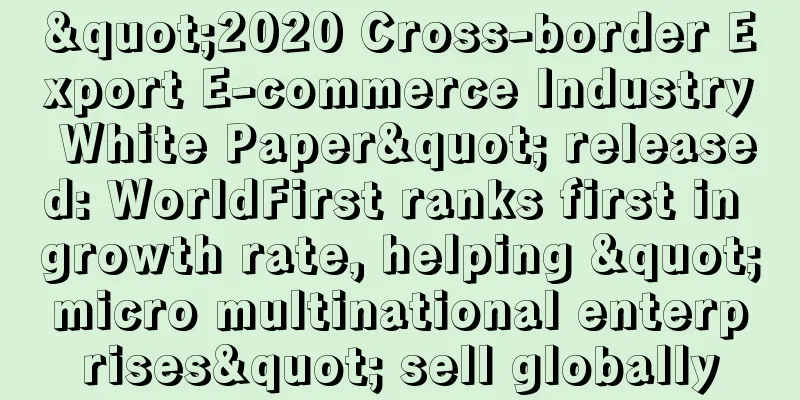"2020 Cross-border Export E-commerce Industry White Paper" released: WorldFirst ranks first in growth rate, helping "micro multinational enterprises" sell globally

|
@Friends of cross-border e-commerce sellers, get the freshly-made dry goods for free! Scan the QR code at the end of the article or click the link to read the original text to download the high-definition version of the "2020 Cross-border Export E-commerce Industry White Paper" immediately !
What forward-looking implications does the change in the cross-border e-commerce market in 2020 have for the development and transformation of the cross-border e-commerce industry in 2021 and beyond? On April 19 , CBNData released the "2020 Cross-border Export E-commerce Industry White Paper", which analyzed the changes in the market in 2020 in detail and predicted that the scale of cross-border e-commerce will reach a new high in 2021.
Next, let’s take a look at the key points in the report with the editor ↓
Cross-border e-commerce transactions continue to rise, and logistics and payment have become key links in optimizing overseas links
According to the CBNData report, the scale of China's cross-border e-commerce transactions has continued to rise in recent years. According to the data from the General Administration of Customs, China's cross-border e-commerce imports and exports reached 1.69 trillion yuan in 2020, an increase of 31.1%. Among them, exports reached 1.12 trillion yuan, an increase of 40.1%. China's cross-border e-commerce is dominated by exports, accounting for nearly 70% in 2020; in the first quarter of 2021, the growth rate of China's cross-border e-commerce exports far exceeded that of imports, reaching 69.3%. In the post-epidemic era, cross-border export trade is coming strongly.
The continuous optimization of logistics, payment and other overseas links is the key to the smooth sailing of cross-border e-commerce sellers. From August 2019 to July 2020, China accounted for 60% of the global cross-border e-commerce packages, and China's cross-border e-commerce export logistics demand dominates the world. The surge in demand has also put forward higher requirements for the level of logistics services, and overseas warehouses have emerged. The essence of overseas warehouses is the localization of cross-border trade, which has advantages in reducing logistics costs, speeding up logistics timeliness, increasing product exposure, and improving shopping experience.
The third-party cross-border payment market is booming, with WorldFirst having the fastest growth rate in 2020
As another key link in the service chain, the third-party cross-border payment market is also booming. A large number of cross-border payment institutions such as WorldFirst are competing with each other, and they are working with domestic licensed institutions to jointly promote cross-border e-commerce. The CBNData Report points out that cross-border payment platforms not only reduce the cost and threshold of financial services by technical means, and increase the frequency of user use, but also have the advantages of fast, convenient and high security, and have become an indispensable payment channel.
Source: " 2020 Cross-border Export E-commerce Industry White Paper"
Taking WorldFirst, the fastest growing cross-border payment platform in 2020, as an example, it adopts a capped fee rate of 0.3%, which is far lower than the industry average of 0.6%-0.7%, giving more benefits to cross-border merchants. More and more cross-border e-commerce sellers use WorldFirst, and with its safe and reliable brand advantage, WorldFirst has processed more than 85 billion pounds of financial transactions for 650,000 customers worldwide so far, and its performance is remarkable among cross-border payment platforms in 2020.
According to the feedback from the cross-border e-commerce merchant survey, the speed of withdrawal is very important. In the past, the overall payment cycle was at least 3 to 4 months. If the withdrawal is delayed by one day, the impact on the seller may be "immeasurable". In order to solve the pain points of sellers' difficulty and slow withdrawal, WorldFirst launched products and services such as quick payment and withdrawal to Alipay, which won the recognition of many cross-border e-commerce sellers.
Four major trends in cross-border export e-commerce are highlighted
1. Market analysis: Demand in Southeast Asia surges, and Chinese products are emerging as a new outlet for export From the perspective of e-commerce platforms, cross-border e-commerce companies are deeply integrated into the global market. Among them, the North American and European markets are the most mature, and are the choice of more than 50% of cross-border e-commerce sellers. It is worth noting that the Southeast Asian market has been very popular in recent years, becoming the third largest emerging market after Europe and the United States. The rise of cross-border e-commerce platforms such as Lazada and Shopee has carried out large-scale recruitment of Chinese merchants, bringing new opportunities for Chinese products to go overseas.
In addition, Latin America and the Middle East present a high-quality blue ocean prospect for cross-border e-commerce, and e-commerce platforms such as Mercado Libre and Noon are beginning to emerge .
2. Product categories: The "cross-border home economy" is in full swing, and home furnishing products are popular overseas In addition to epidemic prevention supplies, home economy-related products such as electronic products and household appliances have become another major contributor to China's foreign trade exports during the epidemic. According to the CBNData "Report", among China's home economy exports, laptops, tablets, and household appliances grew by a total of 22.1%, driving the overall export growth by 1.3 percentage points. In addition to home appliances and 3C products, home furnishing products are extremely popular and have jumped to the top of the category list. According to the CBNData "Report", the proportion of merchants operating furniture and home furnishing products has reached nearly 50%. From the perspective of overseas consumption data, the growth rate of consumption of kitchen appliances and storage home furnishings is the most prominent.
The consumption growth rate of kitchen appliances such as food processors /dough mixers, air fryers, and multi-function cooking pots is far ahead. It can be seen that under the shadow of the epidemic, more and more overseas consumers have begun to focus on diet and attach importance to family.
3. Small but beautiful: Global online consumption is "irreversibly penetrated" and "micro multinational enterprises" sell globally
The home life caused by the epidemic has led to the rapid expansion of online channels in the demand for the home economy. More and more overseas consumers are accustomed to e-commerce shopping. Amazon, eBay, and the Brazilian e-commerce market have all seen a surge in users, and online consumption has achieved "irreversible penetration."
Changes in participants in the cross-border e-commerce market: Previously, most global trade players were large companies, but now with the help of digital platforms, entrepreneurs and small businesses have joined in, operating in multiple markets and becoming micro-multinational companies. They are providing a variety of "Made in China" and light customization services to global buyers.
Portrait of this group: typical small and micro enterprises, many of which are start-ups with less than 100 employees ; backed by the vast Made in China industry, they make better use of digital platforms, and even new players can quickly complete product selection, procurement, sales, logistics, customs declaration, collection, foreign exchange settlement and tax refund, and other complex businesses that only large companies could handle in the past; at the same time, they operate an average of 3.56 overseas sites, which means that most companies serve three or more overseas markets; of course, they also receive generous rewards. Even under the dual challenges of the epidemic and the trade war, they still achieved a sales growth of 130%.
4. Branding: Brands going global is an inevitable trend. Platforms will move towards branding and segmentation.
Cross-border e-commerce has entered the stage of three-dimensional channel layout. 25% of the Chinese cross-border e-commerce sellers interviewed have opened independent websites. Independent websites have the advantages of precision and flexibility, and will become an important channel for enterprises to break through business ceilings or expand into new markets.
At the same time, e-commerce platforms are also gradually moving towards segmentation. According to a consumer survey by multiorders, among the platforms most popular with consumers, except for Amazon and eBay, the others are segmented platforms or selected platforms such as Newegg and Etsy, which is also an important trend worth focusing on for new entrants in cross-border e-commerce.
Want to get the first-hand full report? Click the link to download https://www.worldfirst.com.cn/static/contenthub/resources |
<<: Cambodia, Japan JICA work together to improve logistics system
>>: 76% of Peruvians trust social network recommendations when buying online
Recommend
What is GOAT? GOAT Review, Features
GOAT is a global authentic shoe trading platform. ...
AliExpress and Amazon become the most visited e-commerce platforms in Spain
Club Ecommerce and EGI Group, Spanish e-commerce ...
Profits of over 500 million! The big seller will become the "landlord" in the United States
At the beginning of the year, Lucky announced tha...
What is Forest? Forest Review, Features
Forest produces many global brands from Japan, cr...
What is BeTree E-commerce Academy (Weishu Education)? BeTree E-commerce Academy (Weishu Education) Review, Features
BeTree E-commerce Academy (Shenzhen BeTree Educat...
The average daily search volume exceeds 30,000, and the number of comments is over 10,000. The octopus fan is popular
A few days ago, the high temperature in the Unite...
Hurry up and prepare your stock! Labeling fees for small and light goods will increase
Recently, Amazon UK released a new announcement, ...
How to attract traffic to independent websites: Business social networking with the rise of overseas social media (Part 2)
This article is a continuation of " The Way ...
In the post-epidemic era, the US children's products industry is experiencing growth
According to data from the NPD Group , the U.S. j...
Ozon opens distribution center in New Riga
Similar to Amazon's FBA, more and more e-comm...
The first batch of foreign trade factories that joined AliExpress’s full-management service began to receive a surge in orders
In 2023 , with the changes in the global consumpt...
What is michiny? michiny Review, Features
Founded in New York City in 2010, michiny is a bra...
Health sector budget increased by 138%! India's health market is expected to grow
On February 1, 2020, India's 2021 fiscal budg...
What is Asinzen? Asinzen Review, Features
Asinzen is perfect for online and retail arbitrag...
Amazon's market value could reach 3 trillion US dollars in three years, and BCI's official website removed the "Statement to Boycott Xinjiang Cotton"
BCI official website removes "Statement on B...









